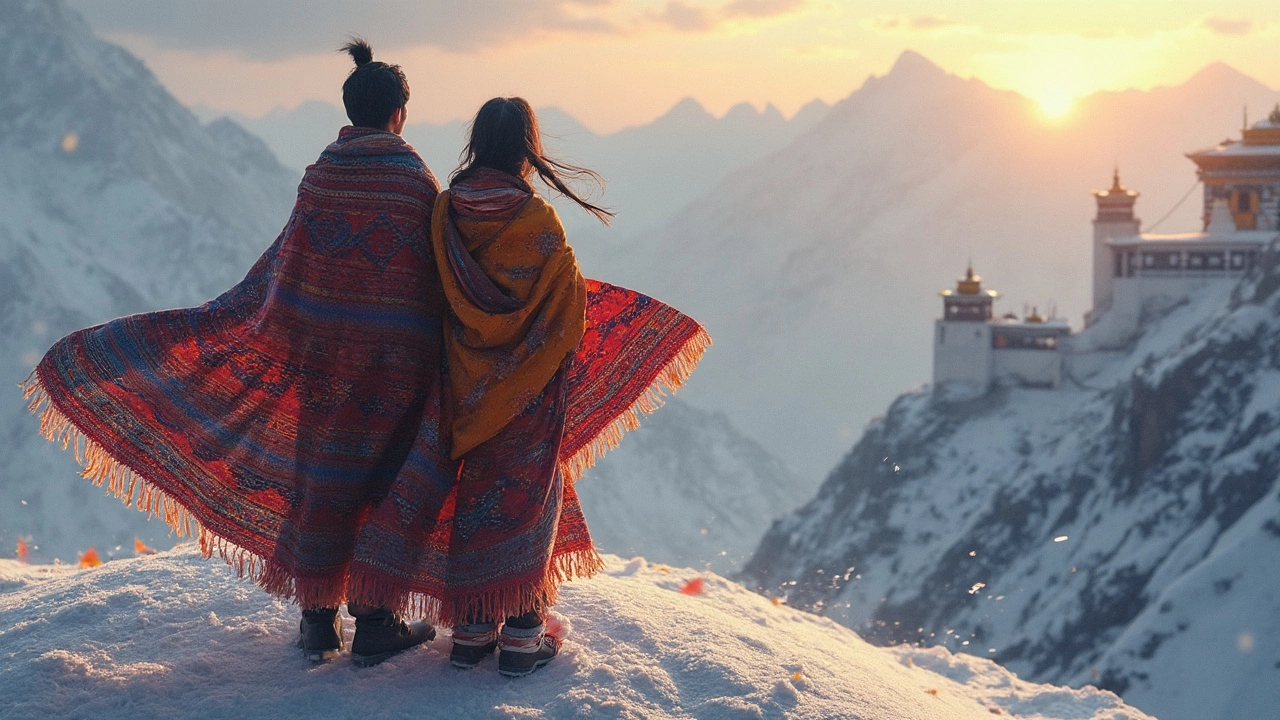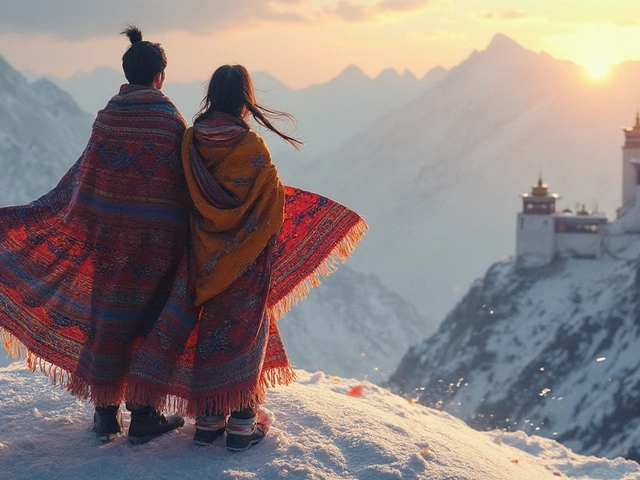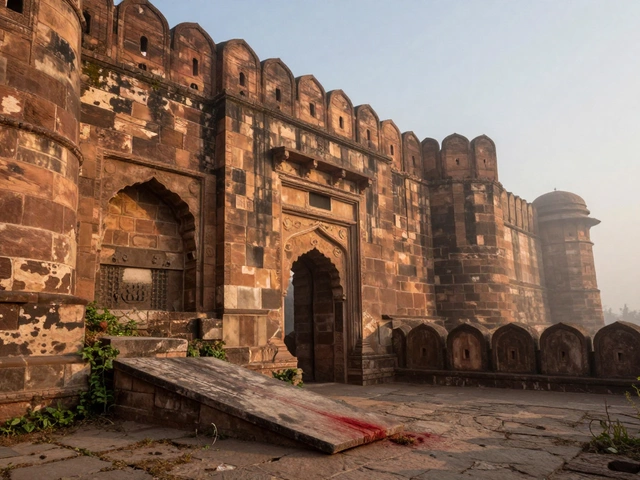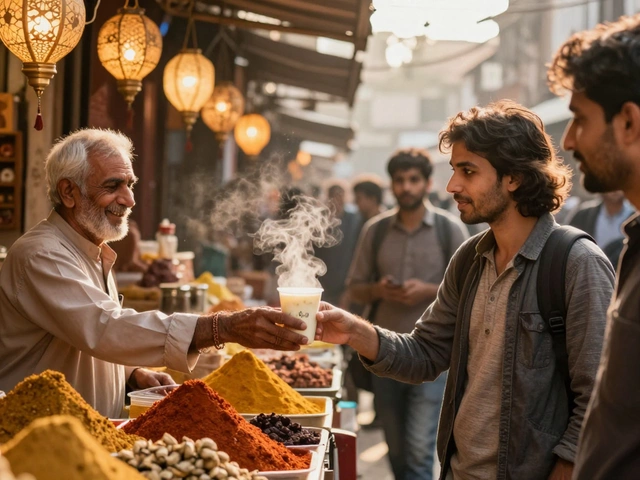The age-old debate: is North India or South India more beautiful? People get surprisingly passionate about this, but the real answer depends on what makes you stop and stare. Are you after snowy mountains or tropical beaches? Ancient palaces or sleepy temple towns?
North India feels like a crash course in drama, with gigantic mountains, sprawling deserts, and cities packed with history. Agra’s Taj Mahal, Jaipur’s pink palaces, the chaos of Varanasi’s ghats—everywhere you turn, there’s something bold and eye-catching. And if you visit in winter, you just might see snow in Manali or Shimla, a total novelty for most travelers.
South India, on the other hand, gives you beaches, backwaters, green hills, and jungles that look straight out of a movie. Think coconut trees, warm breezes, and ancient temples carved with jaw-dropping detail. It’s a vibe: slow mornings by the ocean in Goa (technically Konkan, but still south-ish), lazy boat rides in Kerala, coffee estates in Coorg. The landscapes are lush and people move at a rhythm you can actually catch your breath with.
- How Landscapes Differ
- Cultural Mosaic: North vs South
- Architecture and Heritage
- Food: Spices, Flavors, and Adventures
- Travel Tips and Practicalities
- Choosing What’s Right for You
How Landscapes Differ
When it comes to jaw-dropping landscapes, North and South India could not be more different. North India is flat-out dramatic. You’ve got the mighty Himalayas in the north—places like Leh, Ladakh, Manali, and Shimla are not just famous among trekkers but also families looking for a snowy escape. Just south, the plains open up. The Ganges River carves its way through fertile valleys in Uttar Pradesh and Bihar, while Rajasthan flips the script with its Thar Desert—think endless dunes, camels, and starry nights that feel a world away from any city.
South India is a whole other story. Here, rolling hills and thick jungles meet the ocean. The Western Ghats, a UNESCO hotspot, stretch along the west coast from Maharashtra down to Kerala and Tamil Nadu, brimming with rare wildlife and waterfalls you can actually swim in. Kerala’s backwaters are a totally unique sight: miles of calm lakes, narrow canals, and rice paddies, all best seen from a houseboat. And the beaches? Goa, Karnataka, and Kerala all serve up long stretches of sand and palm trees, with clear water and way fewer crowds the further south you go.
- north india tourism usually spotlights big landscapes—mountains, deserts, deep valleys—and iconic spots like the Taj Mahal and forts perched on rocky hills.
- South India specializes in lush, green scenery—hill stations like Ooty and Munnar, dense forests in Wayanad, and beaches that actually feel peaceful, not packed.
- Monsoon season (usually June-September) turns South India even greener, but also makes trekking harder in the Ghats. North India’s best weather is October to March—cool, clear, and with snow in the hills.
Here’s a quick side-by-side for what you can expect:
| Region | Key Landscapes | Best Known For |
|---|---|---|
| North India | Himalayas, Ganges, Deserts (Thar), Plains | Trekking, Historic Cities, Palaces, Taj Mahal |
| South India | Western Ghats, Backwaters, Lush Forests, Beaches | Beaches, Hill Stations, Houseboats, Wildlife Sanctuaries |
So, when you picture your dream vacation, what jumps out—towering mountains and forts, or morning walks on green hills, boat rides, and beach sunsets?
Cultural Mosaic: North vs South
India’s culture flips fast the moment you cross states—from the clothes to the languages to the festivals. Travel from Delhi to Madurai and you’ll quickly see how big those changes are.
North India is famous for its mix of Mughal and Hindu influences. Hindi, Urdu, Punjabi, and Kashmiri ring out in markets and on streets. There’s Holi with its wild colors in March, massive Eid feasts, and Diwali celebrations that light up every nook and cranny. Weddings here are loud and grand, with baraats (wedding processions) that look like mini-parades. If you’re curious about Sikhism, Amritsar’s Golden Temple is one of India’s most welcoming spots for visitors.
Down south, people speak Dravidian languages like Tamil, Telugu, Malayalam, and Kannada. Temples are the heart of many towns—check out festivals like Onam, Pongal, or the lively dances in Kerala’s Thrissur Pooram with its brightly decorated elephants. Daily life might look a bit more chill, but don’t mistake that for boring. South Indian classical music and dance (like Bharatanatyam and Carnatic concerts) show just how seriously people here take art and tradition.
Check out this quick table to spot some differences:
| Cultural Element | North India | South India |
|---|---|---|
| Main Languages | Hindi, Punjabi, Urdu | Tamil, Telugu, Malayalam, Kannada |
| Major Festivals | Diwali, Holi, Eid | Onam, Pongal, Thrissur Pooram |
| Iconic Clothing | Salwar Kameez, Sherwani, Saree (North-style drape) | Mundu/Veshti, Saree (South-style drape) |
| Weddings | Large, often several days, lots of music and dancing | Temple rituals, classical music, simpler ceremonies in some regions |
| Art Forms | Bhangra dance, Bollywood music | Bharatanatyam dance, Carnatic music |
If you ask anyone who’s traveled both regions, the north india tourism focus often jazzes up first-time visitors. The north keeps things big and bold, while the south’s strengths are its deep roots and softer pace. But both are proud—and not shy about it. Dive into a local festival, wander into a temple, or just eat with your hands—the best way to get culture is to jump right in.
Architecture and Heritage
If you like grand architecture and historic sites, North India throws some real heavyweights your way. Delhi alone packs in Mughal wonders like Humayun’s Tomb and the Red Fort. Then there’s Rajasthan—full of forts like Mehrangarh in Jodhpur and palaces such as the City Palace in Udaipur. And, of course, the north india tourism showstopper: the Taj Mahal in Agra. These places are wildly detailed and often come with stories of kings, battles, or impossible romances. The North’s style often shows off Islamic, Persian, and Rajput influences—expect bold arches, domes, intricate marble work, and massive courtyards.
South India’s heritage is less about huge palaces and more about temples and carvings. Head to Tamil Nadu and you’ll find the towering gopurams (ornate entrance towers) of places like Meenakshi Temple in Madurai or Brihadeeswara Temple in Thanjavur. These temples aren’t just for show; they’re the heart of city life. You’ll also see some of the most detailed and colorful sculptures anywhere. Karnataka stands out for Hampi, an ancient city scattered with temple ruins and giant stone chariots. Kerala mixes things up with its wooden palaces and old mosques influenced by global traders.
If you’re deciding what to see, here are some must-visit architectural icons:
- Taj Mahal (Agra, North): The most famous mausoleum in the world, iconic for good reason.
- Qutb Minar (Delhi, North): A 73-meter tower built in 1193—old and surprisingly well-preserved.
- Mehrangarh Fort (Jodhpur, North): Massive, impressive, and full of quirky museum collections.
- Meenakshi Temple (Madurai, South): Packed with bright sculptures and daily rituals.
- Brihadeeswara Temple (Thanjavur, South): A thousand-year-old masterpiece, still in use.
- Hampi (Karnataka, South): Ruins you can just wander—almost surreal at sunrise.
Don’t just walk past these buildings—ask guides about the quirky legends or peek into smaller side rooms; sometimes that’s where you’ll find the real story. And always check which days are best for visiting. Temples can be packed on festival days, palaces closed for restoration, or you might stumble into a wedding and get invited to join the fun. It pays to be curious.
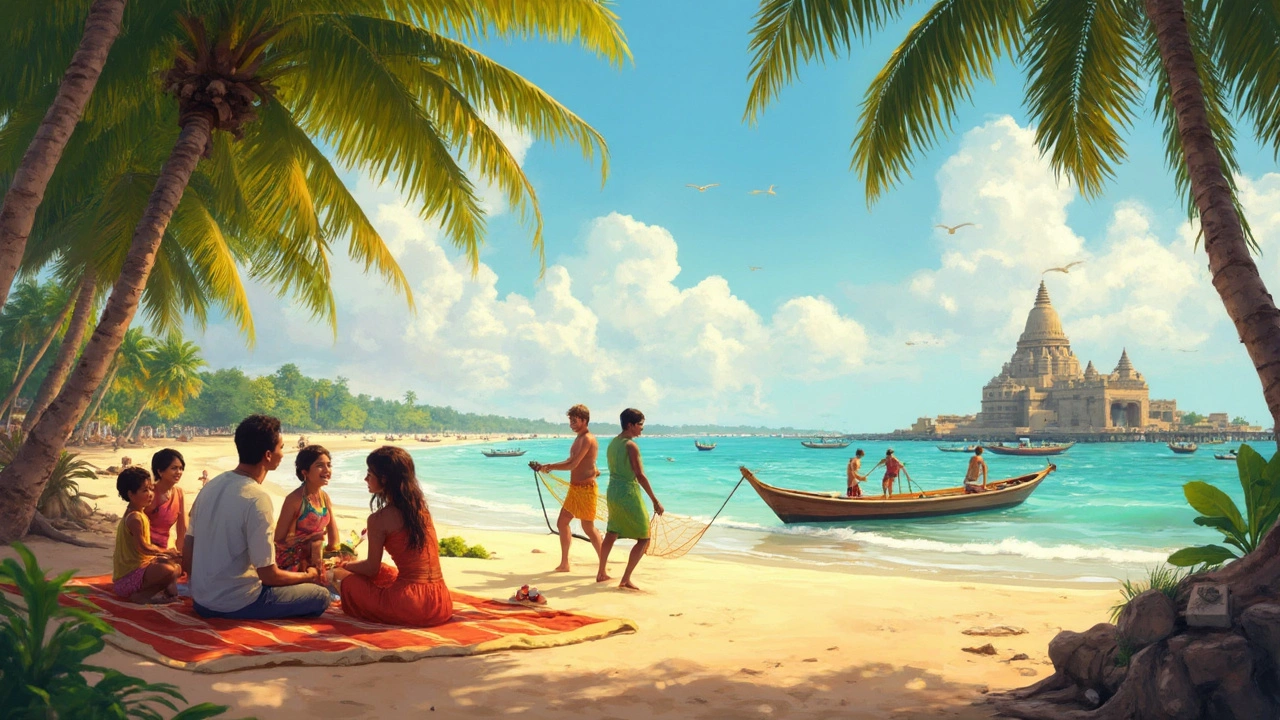
Food: Spices, Flavors, and Adventures
If you love Indian food (or just eating in general), India will never let you get bored. Now, North and South India are like two completely different worlds when it comes to what’s on your plate. Here’s where the biggest flavor battles play out.
North India is famous for rich, creamy gravies and tandoori dishes. Think butter chicken, paneer tikka, samosas, and naan—foods with a serious fan following around the globe. Butter, cream, and lots of wheat make these dishes filling and a little heavy, perfect for chilly northern weather. Ever tried a lassi? You’ll see it everywhere, a cool yogurt-based drink that’s basically North India's answer to beating the afternoon heat.
South Indian food is lighter but just as flavorful. Rice is the base here, with meals like dosa, idli, sambar, and coconut chutney crowding the typical breakfast table. The spices are different, too—black pepper, curry leaves, mustard seeds, and coconut take center stage. Meals in South India are often served on a banana leaf, especially in places like Kerala and Tamil Nadu, which looks cool and keeps things eco-friendly. Grab a piping-hot filter coffee down south, and you’ll see why people get obsessed.
| Popular Dishes | Region | Main Ingredients |
|---|---|---|
| Butter Chicken | North | Chicken, butter, tomato, cream |
| Naan | North | Wheat flour, yogurt |
| Dosa | South | Rice, lentils |
| Sambar | South | Lentils, vegetables, tamarind |
| Chole Bhature | North | Chickpeas, flour |
| Idli | South | Rice, lentils |
Street food? Yes, there are big differences. In the north, try spicy aloo tikki or Delhi’s chaat. In the south, try vada with coconut chutney or spicy Andhra-style biryani. If you’re a fan of strong, layered flavors, you can’t miss the depth found in *north india tourism*—especially in spots like Amritsar or Lucknow, which are legendary for their food.
- North India leans more toward dairy and wheat; South India leans on rice, lentils, and coconut.
- North Indian spices feel milder and warming; South Indian spices have more heat and tang.
- Vegetarians, take note: Both regions have tons of options, but South India has more pure veg restaurants thanks to its huge temple culture.
For anyone traveling with food allergies or sensitivities, both regions use nuts and dairy, but South Indian food often relies more on coconut and less on milk-based cream. Always ask before you order, especially for street food. Tip: If you see a crowded food stall, that’s the one you want.
Travel Tips and Practicalities
Alright, let’s get down to what you really need for a smooth trip in either North or South India. Getting around, figuring out weather, booking hotels—these are the things that can make or break your holiday, no matter how beautiful the place is.
north india tourism knocks it out of the park with train connections. It has some of the fastest, most frequent trains, especially between big tourist cities like Delhi, Agra, Jaipur, and Varanasi. Trains can get booked months ahead, especially in high season (October to March), so jump on those tickets as soon as you can. South India’s trains feel a bit slower, but the scenery—like the Nilgiri Mountain Railway—makes up for it.
Weather is a big deal. North India gets freezing in December and January, but summers (April to June) are painfully hot. South India, with its endless coastline, stays fairly warm all year, but you’ll get drenched in the monsoon. The wettest months down south are June to September. If you want dry, sunny beaches or hill stations, November to February is your window.
- Money Tips: Most places take cards now, but cash is king in smaller towns and rural spots. Carry small bills if you’re hopping in auto rickshaws or grabbing chai on the street.
- Transport Apps: Uber and Ola work in bigger cities across both regions. If you’re trying to negotiate a fair taxi price, ask your hotel for the going rate first.
- Dress Codes: North India is a bit more conservative, especially around temples or rural areas. Carry a scarf or shawl to cover up as needed. South India’s coastal towns are chill, but covering shoulders and knees at temples is still a must.
Finding accommodation is usually simple—there are all kinds of options, from backpacker hostels to splurge-worthy heritage hotels. North India’s big cities get pricey fast, especially around festivals or during the tourist rush. In the south, you’ll find loads of beach huts and cozy homestays that can be booked at the last minute, unless it’s Christmas or New Year’s in Goa.
Here’s a quick look at some numbers you might want to know:
| Region | Best travel months | Avg. daily budget (USD) | Popular transport |
|---|---|---|---|
| North India | Oct - Mar | 30 - 80 | Train, car, tuk-tuk |
| South India | Nov - Feb | 25 - 75 | Train, bus, taxi |
One last thing: hygiene and eating out. Eat at busy places where the food moves quickly; if it looks empty, keep walking. Pack hand sanitizer and don’t drink tap water—even Luna the dog wouldn’t risk it. Bottled water is cheap and everywhere.
Choosing What’s Right for You
So, you’ve read about the wild landscapes, legendary food, and cultural quirks, but you’re still stuck on the big question: north or south? It’s a real decision if you’ve got limited days, a specific budget, or want the trip to match your vibe. Let’s get into what really helps you decide.
Ask yourself what you want out of the trip. If you want to see world-famous monuments like the Taj Mahal, roam giant forts, and maybe catch some mountain snow, you’ll want to focus on north india tourism. History buffs and city lovers usually fall hard for Delhi’s old lanes, Jaipur’s palaces, or Amritsar’s Golden Temple. On the other hand, if slow mornings, green hills, Ayurveda spas, and spicy seafood are your thing, South India wins. Places like Kerala, Hampi, and Pondicherry have a laid-back charm you can’t fake.
Timing makes a difference. North India swelters in summer but becomes magic from October to March, when it’s cool and festivals peek up everywhere. South India stays hot and humid but is best between November and February, especially if you dream of boat rides or hitting the beaches.
| Factor | North India | South India |
|---|---|---|
| Main Attractions | Taj Mahal, Jaipur, Varanasi, Himalayas | Kerala backwaters, Hampi, Mysore, Goa, Coorg |
| Best Season | Oct–Mar (Cool weather) | Nov–Feb (Less rain, mild heat) |
| Popular Foods | Butter chicken, Rogan josh, Chaat | Dosa, Fish curry, Chettinad chicken |
| Typical Budget* | $25–100/day (mid-range) | $20–80/day (mid-range) |
| Language | Hindi, Punjabi, English widely spoken | Tamil, Telugu, Malayalam, Kannada, English in tourist areas |
*Budget varies a lot by city, activities, and whether you pick hostels or fancy resorts.
Here are a few tips for picking the right side:
- If you’re nervous about crowds or pollution, know that some North Indian cities can get wild. South India’s tourist spots usually feel more relaxed.
- Looking for adventure? Himachal Pradesh in the north offers trekking and snow, while the Western Ghats in the south have tea trails and wildlife parks.
- Vegetarians will never go hungry in either place, but in the south, plant-based food is a huge part of daily life. If you love spicy seafood, south is heaven.
- Air connectivity is great in both regions. North has major airports like Delhi, Jaipur, and Varanasi; South has Chennai, Bengaluru, Kochi, and Goa.
- Traveling solo as a woman? Many find Kerala and Tamil Nadu especially comfortable. Big cities in the north are exciting but take usual city safety smarts.
At the end of the day, you really can’t go wrong. Both North and South India have their own brand of beauty and chaos—just pick what fits with your version of an adventure.
